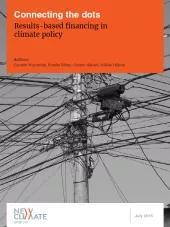In order to reach the goals of the Paris Agreement, it is essential to rapidly move from a zero-sum offsetting approach towards rapid transitions to decarbonise all emitting sectors. Though originally developed for offsetting, using aspects of carbon market mechanisms to deliver results-based finance can have an important role in climate change mitigation and climate finance mobilisation goals. Such finance can either go towards helping host countries achieve their NDCs or in order to create an overall climate benefit. Various aspects and infrastructure built for carbon markets can be used as a vehicle to deliver such results-based finance. This paper discusses a number of limitations of using aspects of carbon market mechanisms for results based finance, ways to address some of those challenges and suggests a niche role for such results based finance to play in the Paris era.
Main findings:
A key strength of using aspects of carbon market mechanisms for results-based climate finance is their ability, when properly implemented, to provide a unit that is quantified, monitored, reported, and verified in a relatively standard comparable metric – CO2e. Further advantages include provision of the infrastructure to “crowdfund” mitigation projects by connecting multiple small donors with projects on the ground with some measure of transparency. Under a results-based payments scheme, the metric(s) could be broadened to include, for example, sustainable development criteria.
Using carbon markets for results-based climate finance however also faces a number of challenges and limitations, which vary somewhat depending on the country, kind of project, and use of units.
These include:
- Generally, the CO2e metric leads to a focus on the cheapest mitigation options rather than otherwise inaccessible high hanging fruit that especially developing countries need to focus on in order to drive transformative change. Selling one’s cheapest mitigation options risks undermining current climate efforts as well as future ratcheted ambition.
- The fact that risks are primarily borne by the project developers creates a bias towards activities that will reliably deliver reductions in the near future and against smaller developers, community projects, and innovative but risky early stage technologies.
- Depending on the technology and methodology, the degree of accuracy associated with measuring “results” can come at a high transaction cost for baseline development, monitoring, reporting, verifying, and issuing credits.
- Projects that need a constant stream of revenue to continue their emission abatement activity may need more than one off disbursements of finance and have not always fared well with carbon market finance and associated market volatility.
- The ex-post financial incentive nature of results-based finance does not address challenges of additionality, and perverse incentives inherent in a comparison to a baseline approach.
- A metric based on tonnes of CO2e reduced is not particularly well suited to support action in least developed countries that have few emissions to reduce, unless problematic assumptions such as “suppressed demand” are used to inflate baselines.
- Depending on the sustainable development goal and target, there are various approaches and challenges to measuring sustainable development. Although there is some movement to change this in voluntary markets, many projects with finance mobilised through carbon markets so far have targeted emission reductions with little to no sustainable development considerations, and sometimes even detrimental impacts.
Some of these challenges can be addressed. Results based finance providers, policy makers, carbon credit standards, emission project developers, and development practitioners can work both individually and collectively to come up with new solutions. Some of these are already being undertaken by various actors, including:
- Placing an emphasis on quality over quantity – including by focussing on specific regions and specific technologies that are most likely to build capacities and foster technology transfer rather than generally just going after the cheapest possible option.
- Opportunities to streamline and reduce transaction costs should be sought out. When credits are not used for offsetting, it may make sense to review if some of the aspects associated with offsetting such as strict and exact baseline setting and MRV costs are really necessary and to what extent finance may be better spent on taking action on the ground. Such steps should however be taken with caution as downplaying stringency requirements could be a potentially dangerous precedent, especially to ensure that RBF-designated credits are not counted as offsets to claim carbon neutrality.
- Providing longer term reliable finance rather than one off disbursements can increase stability and feasibility for projects that are dependent on ongoing finance to continue their emissions abatement activity.
- Shifting from rewarding to enabling – or mixing the two can be an important way to further ambition and impact. This can be done for instance by entering into partnerships with host countries to ensure the continuation of the abatement activity after a certain period of RBCF support.
- Further, other enabling measures such as loan or grant schemes could help to support preparatory measures in cases where such upfront costs present a significant barrier to project development.
At the same time, results-based finance through carbon market mechanisms is likely not the appropriate policy option for all technologies in all countries. For nascent technologies still in research and development, the risks associated with the uncertainty of a future payment is too high a barrier. For such technologies, grants are likely to be a more suitable form of finance. As technologies mature and gain market share, market rate loans or other financial instruments targeting specific barriers are more appropriate. Results based finance is best suited to a niche where a technology has been proven but is not yet mature and has not gained significant market penetration.




